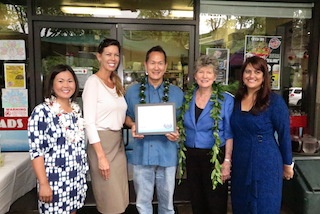Plant Slant

Photo courtesy of Waimea Ocean Film Festival
START THE NEW YEAR ON THE RIGHT FOOT!
A Waimea Ocean Film Festival walking-talk about plants that thrive in our North Hawaii environment - both native and edible - followed by a deliciously healthy "farm-to-table" cooking demo. It’s the next step in connecting Blue Zones Project with our North Hawaii community to help our ohana live longer, better - presented in partnership with Mala’ai School Garden, Waimea Outdoor Circle’s Ulu La’au Nature Park and Blue Dragon restaurant’s “farm-to-table” Chef Noah Hester.
 |
| Chef Noah Hester of Blue Dragon restaurant at Mala`ai School Garden. |
Please join us for a walk-and-talk-story to start the new year on the right foot – making meaningful, sustainable choices to “Live Longer, Better.” Meet at Mala`ai: The Culinary Garden of Waimea Middle School at 7:30 a.m., Sunday, January 3, 2016, for Starbucks coffee and tea, then walk to Waimea Nature Park, Ulu La`au, to meet with Waimea Outdoor Circle volunteers to see and hear about native plants. Afterwards, we will walk back to Mala`ai to learn more about the plants middle school students are growing and eating! This will be followed by a healthy cooking class with Chef Noah Hester from the Blue Dragon. Learn about how the Blue Dragon Farm in North Kohala grows food to support its restaurant, and how you can create tasty, freshly harvested recipes from this talented young chef.
RSVP:
Patti Cook
cookshi@aol.com
(808) 937-2833
or
Carol Ignacio
CarolR.Ignacio@healthways.com
(808) 202-4958
Come January 1, you may also sign up at the Waimea Ocean Film Festival headquarters at the Kahilu Theatre Lobby – sooner is better!
Please wear comfortable shoes and dress in warm layers in case Waimea's wild winter weather rolls in! Please also bring your own plate – must be just 10-inches – both to minimize waste generated by the event, and to honor Blue Zones researched-based strategy of making it easier to enjoy smaller portions.
This event it is FREE thanks to kokua by all of the event partners.
We hope to see you there!
Built Environment Policy
Blue Zones Project - North Hawaii Built environment, in the context of Blue Zones Project, refers to the infrastructure supporting active transportation, recreation, and connection with the people and places
 |
|
Built environment expert Dan Burden conducting a walking audit on Mamane Street in Honokaa. |
of a community. Think of the streets, parks, paths, green buffers, other open spaces, buildings, attractions and other destinations which give us both the reason and the means to step out of our houses and into the world around us. A well designed built environment favors distances at a walking scale, eliminating the need to be in a car for our most important and frequent destinations. Our built environment is the framework that encourages – or discourages – active lifestyles, natural movement, and social interaction through walking, biking, hiking, learning and playing together. As such, it is a critical component of healthy, thriving communities and a key pillar of the Blue Zones Project program.
On November 5, steps were taken toward defining built environment goals as part of the Blue Zones Project – North Hawaii initiative.
Nationally renowned active living champions Dan Burden and Samantha Thomas were on-hand to facilitate workshops in Hilo, Waimea, and Honokaa which drew participation from residents, civic leaders, community organizations, business leaders, advocates, government agencies and officials. The purpose of these workshops was to bring together leaders and neighborhood visionaries to identify shared values. This group included a range of community stakeholders, who gathered together to identify built environment priorities which support those values. The interactive working sessions featured a brief presentation on the principles of place-making and healthy communities, as well as partnership-building and visioning exercises. Dan and Samantha also led group walking audits to give participants a firsthand “feet on the street” experience of walkability and active living concepts.
The Waimea workshop, co-hosted by the Waimea Community Association, reaffirmed the community’s overwhelming support for projects such as the Waimea District Park and the Waimea Trails and Greenways path. Stakeholders also expressed a desire for a network of trails linking schools, residences, and shopping areas; a distinctive town center; and more roadside trees to beautify the area, discourage speeding, provide shade, and serve as natural drainage features.
In Honokaa, the main focus was on supporting Honokaa Elementary School’s application for a Safe Routes to Schools grant. The workshop yielded many ideas and options for improving pedestrian safety which could benefit not only children going to school, but senior citizens, park users, and visitors to the town as well, helping to curb some of the parking issues experienced during special events like First Friday and football games.
Reflecting over the time spent in these communities, Burden had the following sentiments to share. "These places are special, and they must remain so. It has become necessary to set aside all that might divide, to unite with purpose, to retain nature and natural spaces, to create or strengthen town life, to find purpose in a trail, in a new town center, a safer route to school, or to protect an existing town center. Working on any town plan is organic, there is no beginning or ending point, but the best/healthiest and most prosperous towns are those where visions are bold, practical and engaging.”
These are only highlights of the visions put forth by each working group. Based on experiences in communities throughout the nation, it is important for participants, and others just now learning of these efforts, to act in unison to get both short term and long term solutions on the ground. A report of findings from each workshop is being prepared which will include recommendations on how best to organize community assets and efforts around short-term and long-term project and policy goals toward a healthier, more active environment. For those who are interested in staying involved in built environment policy, please contact Carol Ignacio, Blue Zones Project Community Program Manager for Hawaii Island at CarolR.Ignacio@healthways.com.







